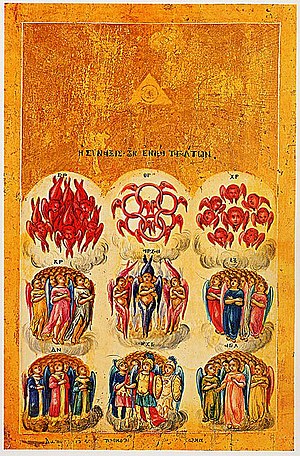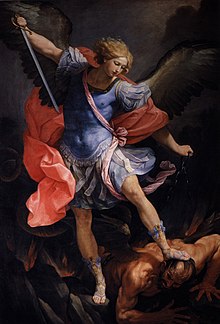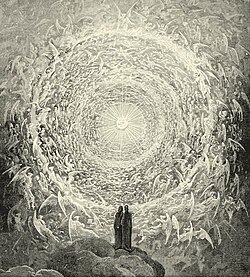Christian angelology
This article needs additional citations for verification. (March 2021) |


In Christianity and Judaism, angels are the agents of God.[1] Various works of Christian theology have devised hierarchies of angelic beings. The most influential Christian angelic hierarchy was that put forward around the turn of the 6th century AD by Pseudo-Dionysius the Areopagite in his work De Coelesti Hierarchia (On the Celestial Hierarchy). He claimed to be an important figure who was converted by Paul the Apostle, who authored most of the New Testament, and his work enjoyed greater influence than it would have if he had used his actual name, until Erasmus publicised doubts about the age of the work in the early 16th century.[2]
Angels are organized into several orders, or "Angelic Choirs".[3][4]
As referred to in the theological doctrine of the communion of saints, in paradise there is a common and unique vision of the truth and contemplation of the face of God, without any kind of difference between angels or human souls. The Summa theologiae states that there exists different degree in respect of the creation, about the power of intercession to God and of direct entrustment in the human lives.
First Sphere[]
The first sphere angels serve as the heavenly servants of God the Son incarnated. The first Sphere of angels see and worship God directly, and they communicate His will to angels who are closer to the life of man.[5]
Seraphim[]
Literally translated, Seraphim (singular "Seraph") are "burning ones". Seraphim are majestic beings with six wings, human hands or voices when in the presence of God.[6] Seraphim are the highest angelic class and they serve as the caretakers of God's throne and continuously sing praises to God of “Holy, holy, holy is the Lord Almighty; the whole earth is full of his glory.”[7]
Cherubim[]

Cherubim have four faces, one of a man, an ox, a lion, and an eagle (later adopted as the symbols of the four evangelists). They have four conjoined wings covered with eyes (although Revelation 4:8 appears to describe them with six wings like the seraphim), a lion's body, and the feet of oxen. Cherubim guard the way to the tree of life in the Garden of Eden[8] and the throne of God.[9]
The cherubim are mentioned in Genesis, Exodus, 2 Chronicles, Ezekiel and 1 Kings.[8][10][11]
St. Thomas Aquinas imagined Satan as a fallen Cherub.[12]
Thrones[]
The "thrones" (in Latin are called ‘seats’ (sedes)), or elders, are a class of celestial beings mentioned by Paul the Apostle in Colossians.[13] Thrones are angels whom the Creator sits over and discharges His judgments through them.[14]
Second Sphere[]

Angels of the Second Sphere work as heavenly governors of the creation by subjecting matter and guiding and ruling the spirits.
Dominations or Lordships[]
The "Dominations" [15] (lat. dominatio, plural dominationes, also translated from the Greek term kyriotētes, pl. of kyriotēs, as "Lordships") or "Dominions" are presented as the hierarchy of celestial beings "Lordships" in some English translations of the De Coelesti Hierarchia. The Dominations regulate the duties of lower angels. It is only with extreme rarity that the angelic lords make themselves physically known to humans.
Virtues[]
Virtues are known for their control of the elements. Some even refer to them as “the shining ones.” In addition to being the Spirits of Motion, they also assist in governing nature. They also assist with miracles. They are also known for their work encouraging humans to strengthen their faith in God. [14]
Powers or Authorities[]
The "Powers" (lat. potestas (f), pl. potestates) are given their name because they are angels who have power over evil forces, which the angels are able to restrain to keep them from doing harm.[14]
Third Sphere[]
Principalities or Rulers[]
The "Principalities" (Latin: principatus), also translated as "Princedoms" and "Rulers", from the Greek archai, pl. of archē (see Greek root in Eph 3:10), are the angels that guide and protect nations, or groups of peoples, and institutions such as the Church. The Principalities preside over the bands of angels and charge them with fulfilling the divine ministry. There are some who administer and some who assist.[14]
The Principalities are shown wearing a crown and carrying a sceptre. Their duty also is said to be to carry out the orders given to them by the upper sphere angels and bequeath blessings to the material world. Their task is to oversee groups of people. They are the educators and guardians of the realm of earth. Like beings related to the world of the germinal ideas, they are said to inspire living things to many things such as art or science.[16][failed verification]
Paul used the term rule and authority in Ephesians 1:21,[17] and rulers and authorities in Ephesians 3:10.[18]
Archangels[]

The word "archangel" comes from the Greek ἀρχάνγελος (archangelos), meaning 'chief angel', a translation of the Hebrew רַב־מַלְאָך (rav-mal'ákh)[19] It derives from the Greek archein, meaning to be first in rank or power; and angelos which means 'messenger' or 'envoy'. The word is only used twice in the New Testament: 1 Thessalonians 4:16 and Jude 1:9. Only Michael and Gabriel are mentioned by name in the New Testament.[citation needed]
In most Christian traditions Gabriel is also considered an archangel, but there is no direct literary support for this assumption. It is also worth noting that the term archangel appears only in the singular, never plural, and only in specific reference to Michael.[20][21]
The name of the archangel Raphael appears only in the Book of Tobit (Tobias). Tobit is considered deuterocanonical by Catholics (both Eastern and Western Rites), Eastern Orthodox Christians, and Anglicans. The Book of Tobit is not, however, acknowledged by most Protestant denominations, such as Reformed Christians or Baptists. Raphael said to Tobias that he was "one of the seven who stand before the Lord", and it is generally believed that Michael and Gabriel are two of the other six.[citation needed]
A fourth archangel is Uriel whose name literally means "Light of God." Uriel's name is the only one not mentioned in the Western Christian Bible, but plays a prominent role in an apocryphon read by Anglican and Russian Orthodox Christians: The second Book of Esdras (fourth Books of Esdras in the Latin Vulgate). In the book, he unveils seven prophecies to the prophet Ezra, after whom the book is named. He also plays a role in the apocryphal Book of Enoch, which is considered canonical by the Ethiopian Orthodox, Eritrean Orthodox, and Ethiopian Catholic Churches. The Catholic Church generally does not regard Uriel as an angel[22] just as the Book of Enoch is not part of the Catholic Bible used by most Catholics[23] either.
Another possible interpretation of the seven archangels is that these seven are the seven spirits of God that stand before the throne described in the Book of Enoch, and in the Book of Revelation.[24]
The Seven Archangels are said to be the guardian angels of nations and countries, and are concerned with the issues and events surrounding these, including politics, military matters, commerce and trade: e.g. Archangel Michael is traditionally seen as the protector of 'Israel' and of the ecclesia (Gr. root ekklesia from the New Testament passages), theologically equated as the Church, the forerunner of the spiritual New Israel.[citation needed]
An additional angel, Metatron, which entered the Christian tradition via Christian Kabbalah, is described in the Babylonian Talmud as a heavenly scribe and in the Zohar as the king of the angels. The apocryphal Books of Enoch (especially 3 Enoch) tell that Metatron was previously the biblical Enoch, who, upon his ascension to Heaven, was transformed into an archangel and given the name Metatron. He was then bestowed the positions of chief of the archangels, and told the secrets of creation.[citation needed]
Angels[]

The "angels" or malakhim (Heb.: מַלְאָכִים), i.e. the "plain" angels (Gr.: ἄγγελοι, pl. of Gr.: ἄγγελος, angelos, i.e. messenger or envoy), are the lowest order of celestial beings, and the most recognized. They are the ones most concerned with the affairs of men. Within the category of the angels, there are many different kinds, with different functions. The angels are sent as messengers to humanity. Personal guardian angels come from this class (Matthew 18:10).
Personal guardian angels[]
Personal guardian angels are not of a separate order, but rather come from the order of Angels. It is a common belief among Christians that they are assigned to every human being, Christian or not.[25]
Choirs in medieval theology[]
This section does not cite any sources. (March 2021) |

Individual angels and demons from the choirs[]
- Seraphim: In John Milton's Paradise Lost Satan and the Archangels belong to this choir ("archangel" has here the meaning of "most powerful angel", not the members of the second lowest choir). Beelzebuth is also addressed as prince of the seraphim in witchcraft litanies.[26]
- Cherubim: In Paradise Lost, Beelzebub and Azazel were cherubim before their fall. St. Thomas Aquinas in Summa Theologica states that Satan belongs to this choir, not to the seraphim.
- Thrones: Paradise Lost cites the demons Adramelec and Asmodai. Some sources mention Astaroth as well.[26][27]
- Virtues: Witchcraft litanies mention Belial.[26]
See also[]
- Classification of demons
- Christian demonology
- Dynamics of the celestial spheres
- Fallen angel
- Heavenly host
- Hierarchy of angels
- Islamic angelic hierarchy
- Jewish angelic hierarchy
- Ye Watchers and Ye Holy Ones
- Zoroastrian angelic hierarchy
References[]
- ^ Barker, Margaret (2004). An Extraordinary Gathering of Angels, M Q Publications.
- ^ "Pseudo-Dionysius the Areopagite". The Stanford Encyclopedia of Philosophy. Metaphysics Research Lab, Stanford University. 2019.
- ^ Chase, Steven (2002). Angelic spirituality. p. 264. ISBN 978-0-8091-3948-4.
- ^ McInerny, Ralph M. (1998). Selected writings of Thomas Aquinas. p. 841. ISBN 978-0-14-043632-7.
- ^ Baines, Wesley. "The Spheres of the Christian Angelic Hierarchy". www.beliefnet.com. Retrieved 2021-03-15.
- ^ "Strong's H8314 - Saraph". Blue Letter Bible. Retrieved 2015-04-01.
- ^ "Bible Gateway passage: Isaiah 6:1-7 - New International Version". Bible Gateway. Retrieved 2021-03-16.
- ^ Jump up to: a b "Genesis 3 - NET Bible". Bible.org. Retrieved 2007-03-13.
- ^ "Ezekiel 10 - NET Bible". Bible.org. Retrieved 2008-11-10.
- ^ "Ezekiel 10 - NET Bible". Bible.org. Retrieved 2007-03-13.
- ^ "1 Kings 6 - NET Bible". Bible.org. Retrieved 2007-03-13.
- ^ "SUMMA THEOLOGICA: The malice of the angels with regard to sin (Prima Pars, Q. 63)". Newadvent.org. Retrieved 2011-12-05.
- ^ "Bible Gateway passage: Colossians 1:16 - New International Version". Bible Gateway. Retrieved 2021-03-16.
- ^ Jump up to: a b c d Isidore, Bishop of Seville (July 2006). The Etymologies of Isidore of Seville (PDF). Translated by Lewis, W. J.; Beach, J. A.; Berghof, Oliver; Barney, Stephen. New York: Cambridge ; New York : Cambridge University Press. p. 161. ISBN 9780521837491.CS1 maint: date and year (link)
- ^ Guiley, Rosemary (1996). Encyclopedia of Angels. New York, NY: Facts on File, Inc.
- ^ King James Bible "Authorized Version" (Cambridge ed.). Cambridge Edition. pp. Ephesian 6:10.
- ^ "NET BibleŽ - Ephesians 1". Bible.org. Retrieved 2011-12-05.
- ^ "NET BibleŽ - Ephesians 3". Bible.org. Retrieved 2011-12-05.
- ^ Strong, J, Strong's Exhaustive Concordance of the Bible, Riverside Books and Bible House, Iowa Falls (Iowa), ISBN 0-917006-01-1.
- ^ The Hope of the Apostolic Church: Or, the Duties and Privileges of Christians in Connexion with the Second Advent, as Unfolded in the First Epistle to the Thessalonians. J. Nisbet & Son. 1845. p. 130.
- ^ Jude 1:9
- ^ Vatican bans rogue angels. Telegraph.co.uk. Retrieved 2019-01-03.
- ^ Why the book of enoch is not included in the bible. Archived 2018-11-06 at the Wayback Machine Catholic.com. Retrieved 2019-01-03.
- ^ Revelation 1:5.
- ^ "CATHOLIC ENCYCLOPEDIA: Guardian Angels". www.newadvent.org. Retrieved 2016-03-05.
- ^ Jump up to: a b c Jules Garinet: Historie de la Magie en France (1818)
- ^ Sebastian Michaelis: The Admirable History of the Possession and Conversion of a Penitent Woman
Bibliography[]
- Barker, Margaret. An Extraordinary Gathering of Angels. M Q Publications, 2004.
- Copeland, Mark. Ministering Spirits: Angels In The Old Testament. Executable Outlines. 2004.
- Copeland, Mark. Terms And Descriptions Of Angels. Executable Outlines. 2004.
- Fares, Aymen. Angelics and the Angelic Realm. Spiritual.com.au Pty. Ltd. 2000.
- Tatum, Johnny. The Hierarchy of Angels: Hierarchical Chart of Angels. Worldnet Grace Ministries.
- Tatum, Johnny. The Hierarchy of Angels: Distinguishing the Higher Ranked. Worldnet Grace Ministries.
- The Bible (Searchable online version)
- Pseudo-Dionysus the Areopagite. The Celestial Hierarchy.
Further reading[]
- C. A. Patrides. "On the orders of angels" (Chapter one). Premises and Motifs in Renaissance Thought and Literature (Princeton, 1982). ISBN 0-691-06505-5.
- Classes of angel
- Angels in Christianity
